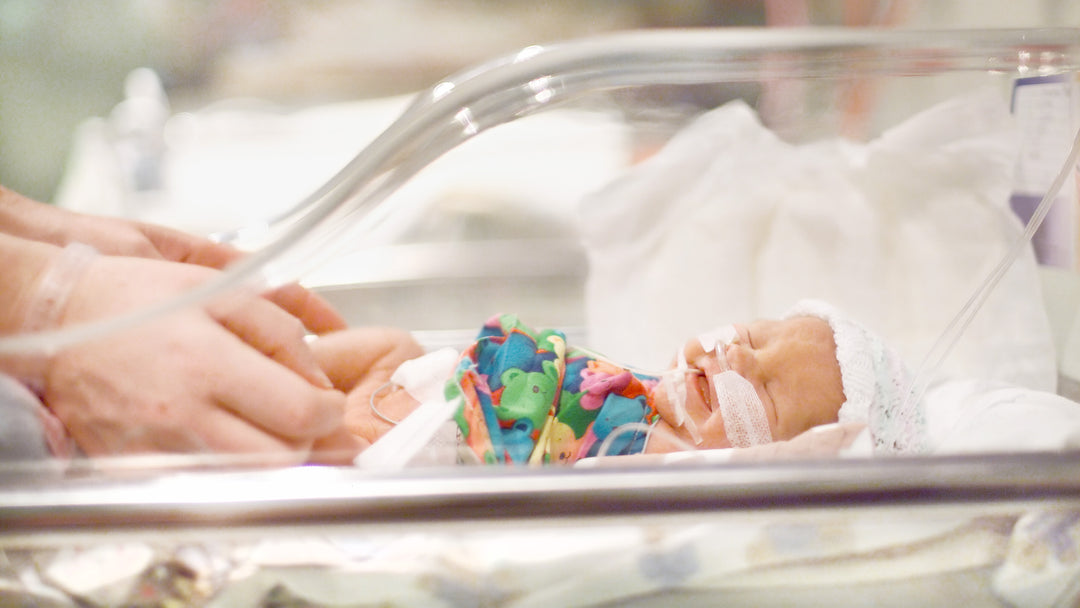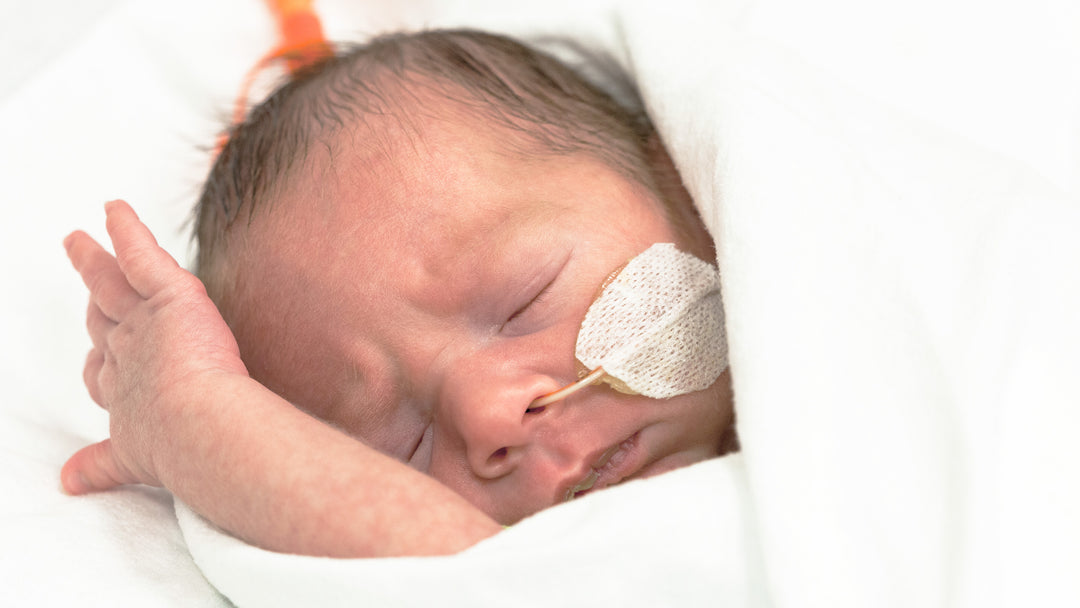We often reflect on the fact that parents usually don't know they are going to have a premature baby. Most commonly we expect to carry the baby nine months, plan our gender reveal, enjoy our baby shower and then be ready for the final count down. Then all of a sudden something unforeseen happens and you find yourself in the NICU. You are thrown in a world of the unknown NICU, and you are trying to figure it all out quickly.
We have compiled a list of NICU terms you may be hearing; it is our hope this will help you get further down the road of understanding what is happening with your little one. They are listed in alphabetical order with an easy to understand definition to help you navigate your way through your NICU journey.
A’s and B’s: These are often the abbreviations for Apnea & Bradycardia they refer to periods of slower breathing and a slower heart rate.
Anemia: A condition in which the red blood cells in the blood, measured by hematocrit, are lower than desired. Red blood cells carry oxygen and carbon dioxide to and from the tissue.
Apnea: A prolonged pause in breathing that lasts more than twenty seconds. This is a common problem in premature infants and requires monitoring and sometimes medication.
Aspiration: Inhaling a foreign substance into the lungs, such as milk, stomach fluids, meconium or amniotic fluid.
Attending Physician: The doctor who has the primary responsibility for coordinating the care for your baby. In the NICU this is usually the Neonatologist.
“Bagging”: A slang term often used in the NICU meaning, to pump air into the baby’s lungs using oxygen and a rubber bag. This method is used temporarily to help a baby who needs help breathing.
"Blow by”: A slang term often used in the NICU meaning, to give a baby a small amount of oxygen through a tube pointed towards the nose.
Bilirubin: A yellow-pigmented waste product that forms when the body naturally eliminates old red blood cells. It may make the skin and eyes look yellow. In premature infants, they are often put under fluorescent light or on a bili blanket to help the levels come down. (also refer to jaundice)
Blood gas: A blood test used to evaluate an infant’s level of oxygen, carbon dioxide, and acid. This helps to assess an infant’s respiratory status. This test is done by a heel stick, blood is taken from the umbilical catheter or from the artery near the wrist.
Blood pressure: The pressure of the blood in the arteries with each pulsation of the heart.
Bradycardia (Brady): A slowing of the baby’s heart rate.
Cardiologist: Is the Doctor who specializes in the heart and circulation
Chem strip: (blood sugar or dex stick): Testing of the baby’s blood sugar level.
Case Manager: A staff member who interfaces with insurance agencies regarding medical necessity and length of stay, as required, helps with discharge planning, arranging for medical equipment and visiting nurses when necessary. Many insurance companies also have CASE MANAGERS who are assigned to customize and individualize benefits for those with extensive or complex health care needs.
Central Catheter or Central Line: A thin, flexible tube (catheter) placed in a larger vein or artery to deliver medications or necessary fluids and nutrients to the body. Broviac catheters are usually placed in the upper chest and tunnel under the skin to enter the vena cava, the large blood vessel in the center of the body carrying blood to the heart. PICC lines (percutaneously inserted central catheters) are usually threaded through a vein in the arm to the vena cava. Central catheters also include umbilical venous and umbilical artery catheters which may be inserted into the vein or artery of the umbilical stump (belly button) shortly after birth.
Chemstrip: A test in which a drop of the baby's blood is placed on a strip of special paper to determine the amount of sugar in the blood.
Chest Tube: A small plastic tube placed through the chest wall into the space between the lung and chest wall to remove air or fluid from this space.
Congenital: Existing at the time of birth.
Chronologic Age: A baby’s age based on their actual birthday.
Corrected Age: A baby’s age based on their gestation.
CPAP: Stands for Continuous Positive Airway Pressure - a form of ventilator assistance which helps to keep the baby's lungs adequately expanded. CPAP does not breathe for the baby, but allows the baby to breathe into a "wind."
CT Scan: A digital x-rays which show the size and position of many parts of the brain. A CT scan also can be done on other parts of the body. The baby must go to another area of the hospital to have a CT scan.
Culture: A laboratory test of blood, spinal fluid, urine, or other specimens which shows if germs are present and which ones they are.
Cyanosis: Blueness of the skin as a result of decreased oxygen levels.
"De-satting" or desaturation: A drop of oxygen levels in the baby’s bloodstream.
Differential: A test which divides the white blood cell count (from the CBC) into several categories, chiefly: "polys" (short for polymorphonuclear leukocytes), "bands" (immature "polys"), "lymphs" (lymphocytes), "monos" (monocytes), "cos" (eosinophils), "basos" (basophils). The percentages of each cell type may vary in different kinds of infections; for example, polys and bands usually will predominate in bacterial infections, while the number of lymphs usually will increase in viral infections.
Echocardiogram: A test done to look at the heart using sound waves through the chest wall. This is much like an ultrasound done during pregnancy and is neither harmful nor painful.
Edema: Is referring to "Puffy" skin which is caused by a build-up of fluid in body tissues.
Endotracheal tube (ET tube): A tube that passes through either the baby’s mouth or nose into the windpipe (trachea) to allow oxygen into the lungs.
Gastroenterologist: A medical doctor who specializes in the digestive system.
Gastrostomy: A surgically created opening in the abdominal wall to provide nutrition directly into the stomach.
Gavage feedings (tube feedings or NG- nasal gastric tube): A way of providing nutrition through a plastic tube passed through the baby’s mouth or nose and into the stomach.
Head Ultrasound (HUS): A painless test that uses sound waves to look at a baby’s brain. This test can be done at the bedside in the NICU.
Heart Murmur: Refers to a rushing sound made by the blood within the heart, usually heard with a stethoscope. This may or may not be a sign of a problem for a baby.
"Heel stick”: A slang term often used in the NICU meaning, to obtain a blood sample by pricking the baby’s heel.
High-Frequency Oscillatory Ventilator: A special ventilator capable of breathing for a baby at rates exceeding those of a regular ventilator.
Hypotension: Low blood pressure.
Humor: Is something you used to have before your baby was in the NICU. Don't lose your sense of humor, it will help you get through these difficult times.
Hypoglycemia: When your baby has a low amount of sugar (glucose) in the blood.
Inspiratory Time: Is the length of a forced breath provided to the baby by a ventilator.
Intravenous (IV) therapy: Nutrition or medication given through a catheter that is inserted into a vein
Intubation: Inserting a tube into the trachea (windpipe) through the nose or mouth to allow air to reach the lungs.
"I’s and O’s”: A slang abbreviation often used in the NICU meaning, the amount of fluid, (IV and feeds) baby takes in compared to how much the baby pees and poops out.
Isolette or incubator: A type of enclosed bed for an infant who is not mature or well enough to maintain her body temperature in an open crib.
Jaundice: A yellow skin color that develops in most premature babies and in some full-term babies.
Kangaroo care: Skin-to-skin care where the baby is placed on the bare chest of the mother or father.
“Leads": Monitor wires attached to baby’s skin.
Meconium: A dark green sticky substance found in the baby’s intestines. It’s the first bowel movement after birth.
Monitor: A machine that displays the heart rate, respiratory rate, blood pressure and blood oxygen saturation of the baby.
MRI: A computerized method of viewing any portion of the body. It uses magnetism rather than x-rays. All metal must be removed from around the baby. The baby must go to another area of the hospital to have an MRI.
Nasal cannula: Small prongs placed in the baby’s nose that delivers oxygen
Necrotizing Enterocolitis (NEC): An infection of the wall of the intestines, which may spread to the blood. Premature babies are particularly vulnerable to this disease. Surgery is sometimes necessary to remove the damaged intestine, and the baby may need prolonged feeding by vein until he recovers.
Neonatology: The medical specialty concerned with diseases of newborn infants (neonates). Neonatologists are pediatricians who have received several years of additional training.
Nephrology: A medical doctor who specializes in disorders of the kidneys.
Neurologist: A medical doctor who specializes in the brain and nervous system.
NPO: Latin abbreviation for “nothing by mouth.” If the baby is kept NPO, all nutrition will be given intravenously.
Ophthalmologist: A medical doctor who specializes in disorders of the eye.
Otolaryngologist: A medical doctor who specializes in the ear, nose, and throat.
Patent Ductus Arteriosus (PDA): A small vessel which allows blood to bypass the lungs. This vessel is open while the baby is in the womb but closes typically shortly after delivery. If the vessel fails to close on its own, particular medication or surgery may be needed.
Pneumothorax: A collapsed lung- the collection of air in the space around the lungs. This buildup of air puts pressure on the lung so it cannot expand as much as it usually does when you take a breath.
Pediatrician: A medical doctor who specializes in infants and children.
PICC line (Peripherally inserted central catheter) ): A PICC is a line inserted through a vein and then advanced through increasingly larger veins, toward the heart. Used when IV therapy, antibiotics, or nutrition (TPN/lipids) are administered for an extended period of time.
Phototherapy: Light therapy to treat jaundice. Bright blue fluorescent lights, called bililights, are placed over the baby’s incubator, or the baby may be placed on a blanket that also shines the light up to the baby.
PKU- Metabolic Screen/ newborn screening: A blood test done on special paper that tests for several different genetic disorders. It is often done 24-72 hours after birth and repeated on preemie babies at 2weeks and 4 weeks of age.
Pulse oximeter or "pulse ox": A machine that measures how well the blood is being oxygenated, often found on the feet or wrists.
"Priming the gut": A slang phrase often heard in the NICU often used to describe the slow starting of feeds to get the digestive system ready to start functioning fully. (also termed trophic feeds)
Reflux: A backward flow of stomach contents, generally referring to a type of spitting up or regurgitation common in premature infants.
Respiratory distress syndrome (RDS): Lung disease that is caused by lack of surfactant (lubricant in the lungs) and is a common cause of breathing difficulty in premature babies.
Residuals: The contents left inside the belly at the start of a next feeding.
Sepsis: A potentially fatal and dangerous condition in which the body is fighting a severe infection that has spread via the bloodstream.
Spinal tap/lumbar puncture (LP): A procedure in which a needle is inserted into the lower spine to obtain spinal fluid.
Suctioning: the process of removing secretions from the baby’s nose, mouth or lungs by using either a bulb syringe or suction catheter.
Tachycardia: A fast heart rate.
Tachypnea: A fast breathing rate.
Tracheostomy: A surgical opening in the trachea, below the larynx (voice box) to allow air to enter the lungs; usually done to by-pass a narrowing in the area immediately below the larynx.
Transfusion: Giving donated blood to the baby by vein or artery.
Ventilator (Vent): A machine that helps an infant breathe by pumping oxygen into a tube (called an ET tube) that goes into the lungs.
Warmer: Also known as a Radiant Warmer, an open bed allows maximum access to a sick or newly born infant. Radiant heaters above the bed keep the baby warm.
Wean: To take away gradually. In the NICU, it is often used to describe the process of removing an infant from a ventilator or incubator.
Becoming familiar with these A, B... W’s (apnea, bradycardia, wean) we hope will help you better understand your baby's journey through the NICU. You will soon, not only be accustomed to the lingo, but you too will be speaking this new found language with ease. With that new found knowledge please remember the one in the middle that starts with H (humor) it will certainly be necessary and needed at times.
We hope this is helpful,
Cressie








